Jackson M.J. Micro and Nanomanufacturing
Подождите немного. Документ загружается.


332 Micro- and Nanomanufacturing
going chronologically from the stone age, bronze age, to the iron age
of
the
past and the sihcon age of the present.
7.4 CVD Diamond Technology
The reactor system (comprising the reaction chamber and all associ-
ated equipment) for carrying out CVD processes must provide sev-
eral basic functions common to all type of systems (Fig. 7.1). It must
allow transport of the reactant and diluents gases to the reaction site,
provide activation energy to the reactants (heat, radiation, plasma),
maintain a specific system pressure and temperature, allow the
chemical processes for film deposition to proceed optimally, and
remove the by-product gases and vapors. These functions must be
implemented with adequate control, maximal effectiveness, and
complete safety.
Chemical vapor deposition is a crystal growth process used not
only for diamond but also for a range of different semiconductor and
other crystalline materials such as silicon or gallium arsenide. These
industrial fields are diverse and range from gas turbines to gas cook-
ers and from coinage to nuclear power plants.
The CVD process relies first on the generation of a species that
is produced by the reaction of the element that is to be deposited
with another element that results in the substantial increase in the
depositing elements vapor pressure. Second, this volatile species is
then passed over or allowed to come into contact with the substrate
being coated. This substrate is held at an elevated temperature, typi-
cally from 800 - 1150°C. Finally, the deposition reaction usually oc-
curs in the presence of a reducing atmosphere, such as hydrogen.
The film properties can be controlled and modified by varying the
problem parameters associated with the substrate, the reactor, and
gas composition.

Diamond Microcutting Tools 333
7.5 CVD Diamond Processes
Several different approaches to the deposition of diamond have been
investigated and these include the ones described in the following
sections.
Gas Sources
I
1
Thin
Vapor
Substrate
I ^T
Substrate bolder
Vacuum
Fig.
7.1.
A simple schematic of
a
vapor deposition process
7.5.1 Plasma-Enhanced CVD
Plasmas generated by various forms of electrical discharges or in-
duction heating have been employed in the growth of diamond. The
role of the plasma is to generate atomic hydrogen and to produce the
necessary carbon precursors for diamond growth. The efficiencies of
the different plasma processes vary from method to method. Three
plasma frequency regimes will be discussed. These are microwave
plasma CVD, which typically uses excitation frequencies of 2.45
GHz; Radio-frequency (RF) plasma excitation, which employs fre-
quencies of usually 13.56 MHz, and direct-current (DC) plasmas,

334 Micro- and Nanomanufacturing
which can be run at low electric powers (a "cold" plasma) or at high
electric powers (which create an arc or a thermal plasma).
RF Plasma-Enhanced CVD
Generally, radio-frequency power can be applied to create plasma in
two electrode configurations, namely, in an inductively coupled or a
capacitively coupled parallel plate arrangement. A number of work-
ers have reported the growth of diamond crystals and thin films us-
ing inductively coupled RF plasma methods [21-24] as well as ca-
pacitively coupled methods [25-26]. A high power in the discharge
leading to greater electron densities was found to be necessary for
efficient diamond growth. However, the use of higher power results
in physical and chemical sputtering from the reactor walls, leading
to contamination of the diamond films [21]. The advantage of RP
plasmas is that they can easily be generated over much larger areas
than microwave plasmas but the method is not routinely applied for
the deposition of diamond films.
DC Plasma-Enhanced CVD
In this method, plasma in a H2-hydrocarbon mixture is excited by
applying a DC bias across two parallel plates, one of which is the
substrate [27-29]. DC plasma-enhanced CVD has the advantage of
being able to coat large areas as the diamond deposition area is lim-
ited by the electrodes and the DC power supply. In addition, the
technique has the potential for very high growth rates. However, dia-
mond films produced by DC plasmas were reported to be under high
stress and to contain high concentrations of hydrogen as well as im-
purities resulting from plasma erosion of the electrodes.
Microwave Plasma-Enhanced CVD
Microwave-plasma assisted CVD has been used more extensively
than any other method for the growth of diamond films [14-20]. Mi-
crowave plasmas are different from other plasmas in that the micro-
wave frequency can oscillate electrons. Collision of electrons with
gaseous atoms and molecules generates high ionization fractions.
This method of diamond film growth has a number of distinct ad-
vantages over the other methods of diamond film growth. Micro-
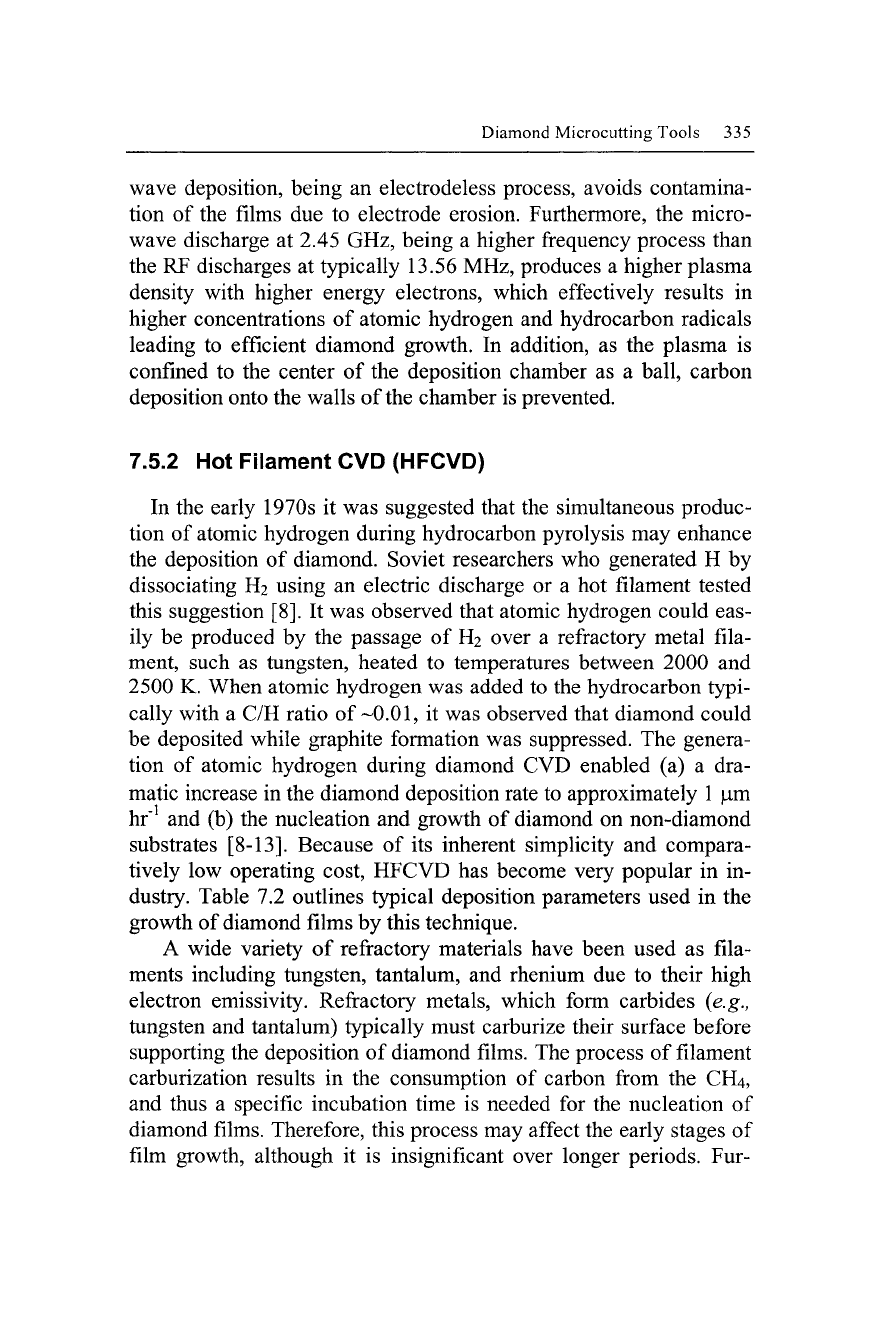
Diamond Microcutting Tools 335
wave deposition, being an electrodeless process, avoids contamina-
tion of the films due to electrode erosion. Furthermore, the micro-
wave discharge at 2.45 GHz, being a higher ft-equency process than
the RF discharges at typically 13.56 MHz, produces a higher plasma
density with higher energy electrons, which effectively results in
higher concentrations of atomic hydrogen and hydrocarbon radicals
leading to efficient diamond growth. In addition, as the plasma is
confined to the center of the deposition chamber as a ball, carbon
deposition onto the walls of the chamber is prevented.
7.5.2 Hot Filament CVD (HFCVD)
In the early 1970s it was suggested that the simultaneous produc-
tion of atomic hydrogen during hydrocarbon pyrolysis may enhance
the deposition of diamond. Soviet researchers who generated H by
dissociating H2 using an electric discharge or a hot filament tested
this suggestion [8]. It was observed that atomic hydrogen could eas-
ily be produced by the passage of H2 over a refractory metal fila-
ment, such as tungsten, heated to temperatures between 2000 and
2500 K. When atomic hydrogen was added to the hydrocarbon typi-
cally with a C/H ratio of
~0.01,
it was observed that diamond could
be deposited while graphite formation was suppressed. The genera-
tion of atomic hydrogen during diamond CVD enabled (a) a dra-
matic increase in the diamond deposition rate to approximately
1
|Lim
hr"^ and (b) the nucleation and growth of diamond on non-diamond
substrates
[8-13].
Because of its inherent simplicity and compara-
tively low operating cost, HFCVD has become very popular in in-
dustry. Table 7.2 outlines typical deposition parameters used in the
growth of diamond films by this technique.
A wide variety of refi'actory materials have been used as fila-
ments including tungsten, tantalum, and rhenium due to their high
electron emissivity. Refractory metals, which form carbides (e.g.,
tungsten and tantalum) typically must carburize their surface before
supporting the deposition of diamond films. The process of filament
carburization results in the consumption of carbon from the CH4,
and thus a specific incubation time is needed for the nucleation of
diamond films. Therefore, this process may affect the early stages of
film growth, although it is insignificant over longer periods. Fur-

336 Micro- and Nanomanufacturing
thermore, the volume expansion due to carbon incorporation leads to
cracks along the length of the wire. The development of these cracks
is undesirable, as it reduces the lifetime of
the
filament.
Table 7.2. Typical deposition parameters used in the growth of diamond films by
HFCVD
Gas mixture Total pressure Substrate tern- Filament tem-
(Torr) perature (K) perature (K)
CH4 (0.5 - 10-50 1000 - 1400 2200 - 2500
2.0%)/H2
It is believed that thermodynamic near-equilibrium is established
in the gas phase at the filament surface. At temperatures around
2300 K, molecular hydrogen dissociates into atomic hydrogen and
methane transforms into methyl radicals, acetylene species, and
other hydrocarbons stable at these elevated temperatures. Atomic
hydrogen and the high-temperature hydrocarbons then diffuse from
the filament to the substrate surface. Although the gaseous species
generated at the filament are in equilibrium at the filament tempera-
ture,
the species are at a super equilibrium concentration when they
arrive at the much cooler substrate. The reactions that generate these
high-temperature species (e.g., C2H2) at the surface of the filament
or anywhere where there are hydrogen atoms, proceed faster than
any reactions that decompose these species during the transit time
from the filament to the substrate. Consider the equilibrium between
methane and acetylene:
2CH4 • C2H2 + 3H2
At the filament surface, the reaction is immediately driven to the
right, creating acetylene. After acetylene diffuses to the substrate,
thermodynamic equilibrium at a substrate temperature of-1100 K
calls for the formation of
methane,
but the reverse reaction proceeds
much slower. Solid carbon precipitates on the substrate in order to
reduce the superequilibrium concentration of species such as acety-
lene in the gas phase. The diamond allotrope of carbon is "stabi-

Diamond Microcutting Tools 337
Used" by a concurrent super equilibrium concentration of atomic hy-
drogen. This simple explanation emphasizes the importance of reac-
tion kinetics in diamond synthesis by HFCVD.
Advantages of the CVD Process
The process is gas phase in nature, and therefore given a uniform
temperature within the coating retort and likewise uniform concen-
trations of the depositing species the deposition rate will be similar
on all surfaces. Therefore, variable and complex shaped surfaces,
given reasonable access to the coating powders or gases, such as
screw threads, blind holes, or channels or recesses, can be coated
evenly without build-up on edges.
Disadvantages of the CVD Process
The CVD process is carried out at relatively high temperatures and
therefore limitations due to dimensional tolerances are an important
consideration. Components that have tight dimensional tolerances
will not be amenable to CVD. However, the reduction of distortion
during coating can sometimes be controlled by careful stress reliev-
ing after rough machining of the component during fabrication.
7-6 Treatment of Substrate
7.6.1 Selection of Substrate Material
Deposition of adherent high-quality diamond films onto substrates
such as cemented carbides, stainless steel, and various metal alloys
containing transition element has proved to be problematic. In gen-
eral, the adhesion of the diamond films to the substrates is poor and
the nucleation density is very low [44-51]. Mainly refractory materi-
als such as W (WC-Co), Mo, and Si have been used as substrate ma-
terials. Materials that form carbide, are found to support diamond
growth. However, materials such as Fe and steel possess a high mu-
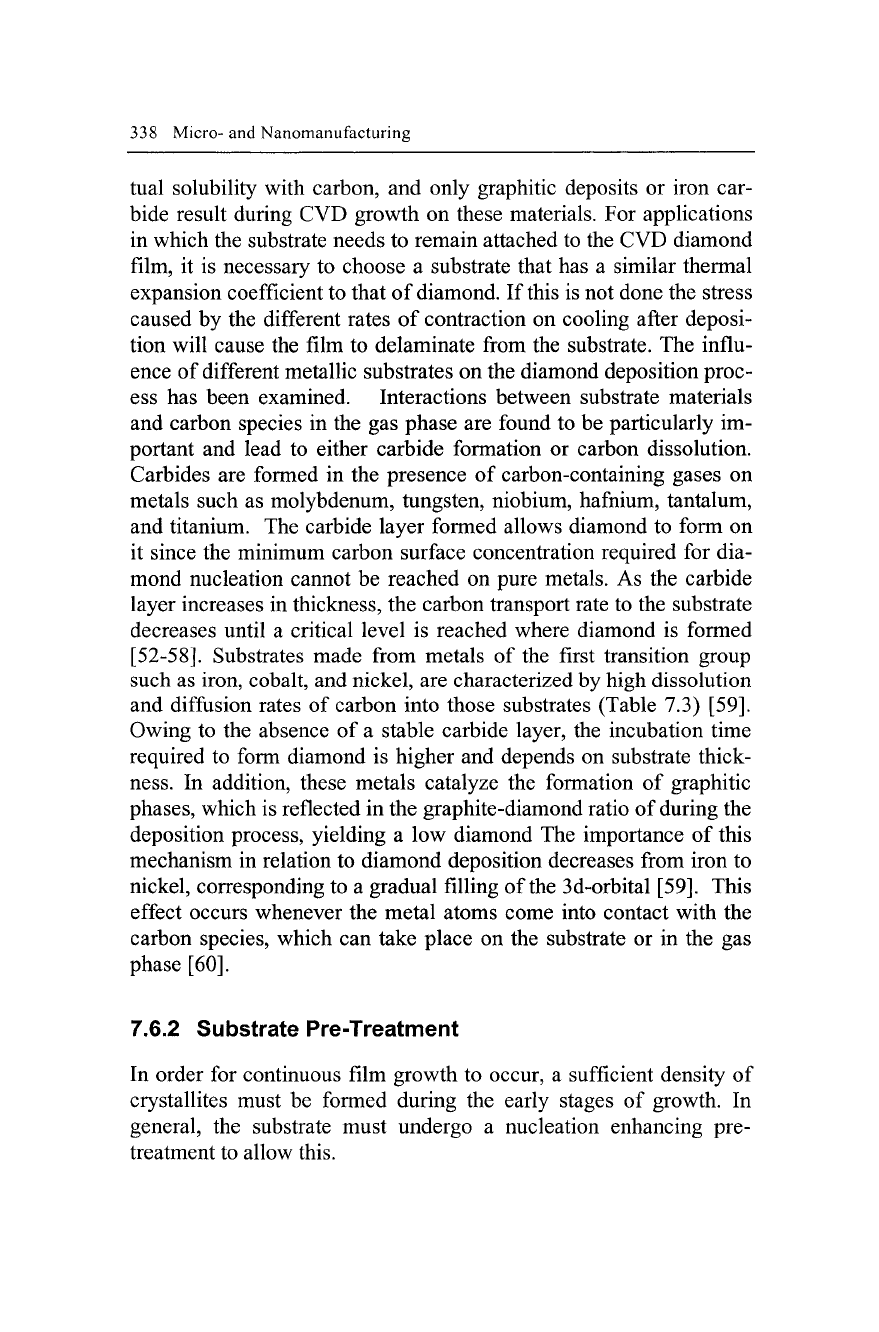
338 Micro- and Nanomanufacturing
tual solubility with carbon, and only graphitic deposits or iron car-
bide result during CVD growth on these materials. For applications
in which the substrate needs to remain attached to the CVD diamond
film, it is necessary to choose a substrate that has a similar thermal
expansion coefficient to that of diamond. If this is not done the stress
caused by the different rates of contraction on cooling after deposi-
tion will cause the film to delaminate from the substrate. The influ-
ence of different metallic substrates on the diamond deposition proc-
ess has been examined. Interactions between substrate materials
and carbon species in the gas phase are found to be particularly im-
portant and lead to either carbide formation or carbon dissolution.
Carbides are formed in the presence of carbon-containing gases on
metals such as molybdenum, tungsten, niobium, hafnium, tantalum,
and titanium. The carbide layer formed allows diamond to form on
it since the minimum carbon surface concentration required for dia-
mond nucleation cannot be reached on pure metals. As the carbide
layer increases in thickness, the carbon transport rate to the substrate
decreases until a critical level is reached where diamond is formed
[52-58].
Substrates made from metals of the first transition group
such as iron, cobalt, and nickel, are characterized by high dissolution
and diffusion rates of carbon into those substrates (Table 7.3) [59].
Owing to the absence of a stable carbide layer, the incubation time
required to form diamond is higher and depends on substrate thick-
ness.
In addition, these metals catalyze the formation of graphitic
phases, which is reflected in the graphite-diamond ratio of during the
deposition process, yielding a low diamond The importance of this
mechanism in relation to diamond deposition decreases from iron to
nickel, corresponding to a gradual filling of the 3d-orbital [59]. This
effect occurs whenever the metal atoms come into contact with the
carbon species, which can take place on the substrate or in the gas
phase [60].
7.6.2 Substrate Pre-Treatment
In order for continuous film growth to occur, a sufficient density of
crystallites must be formed during the early stages of growth. In
general, the substrate must undergo a nucleation enhancing pre-
treatment to allow this.
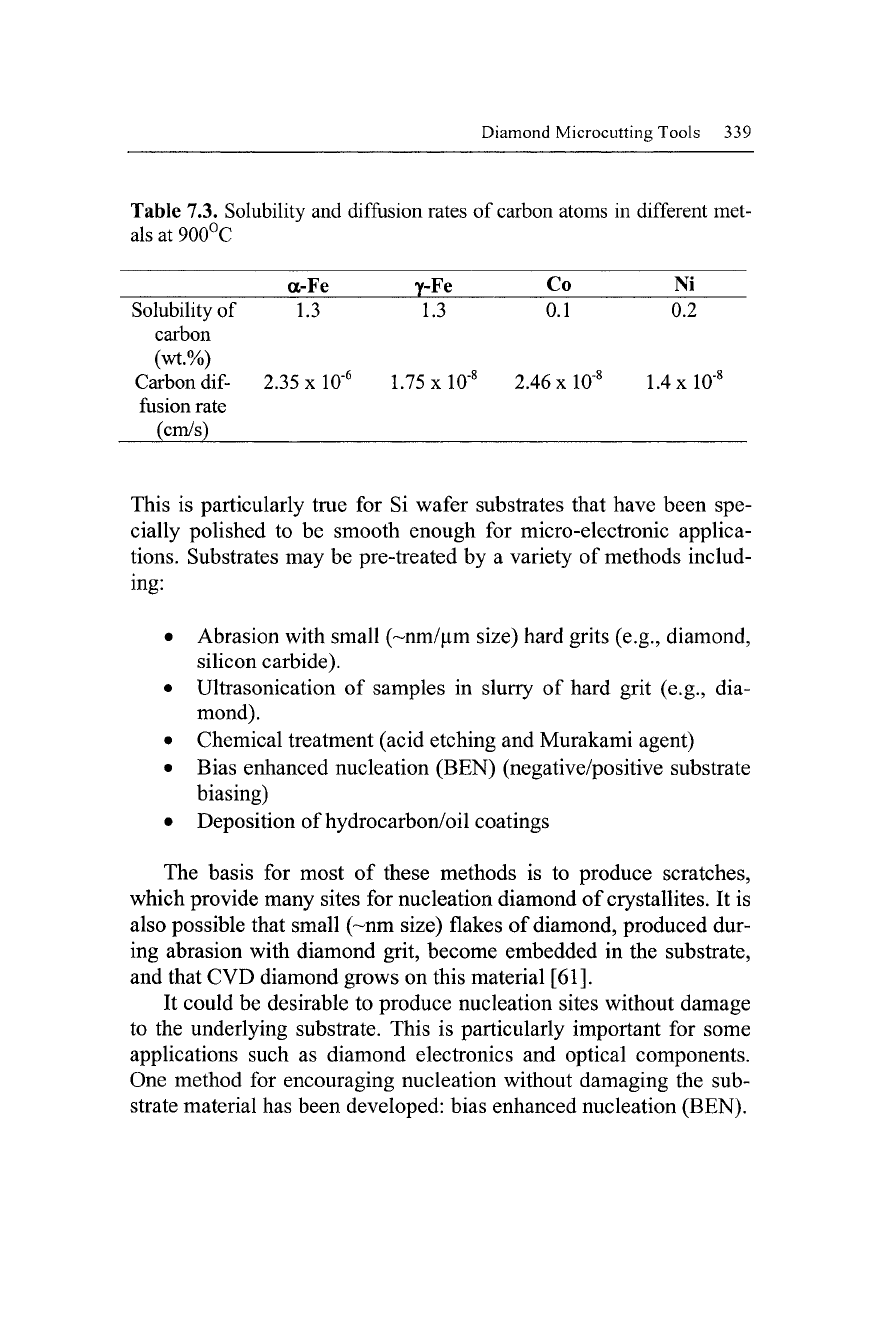
Diamond Microcutting Tools 339
Table 7.3. Solubility and diffusion rates of carbon atoms in different met-
als at 900^C
g-Fe itFe _Co Ni
Solubility of 1.3 1.3 0.1 0.2
carbon
(wt.%)
Carbon dif- 2.35 x 10"^ 1.75 x
10"^
2.46 x
10"^
1.4 x 10"^
fusion rate
(cm/s)
This is particularly true for Si wafer substrates that have been spe-
cially polished to be smooth enough for micro-electronic applica-
tions.
Substrates may be pre-treated by a variety of methods includ-
ing:
• Abrasion with small (~nm/|Lim size) hard grits (e.g., diamond,
silicon carbide).
• Ultrasonication of samples in slurry of hard grit (e.g., dia-
mond).
• Chemical treatment (acid etching and Murakami agent)
• Bias enhanced nucleation (BEN) (negative/positive substrate
biasing)
• Deposition of hydrocarbon/oil coatings
The basis for most of these methods is to produce scratches,
which provide many sites for nucleation diamond of
crystallites.
It is
also possible that small (~nm size) flakes of diamond, produced dur-
ing abrasion with diamond grit, become embedded in the substrate,
and that CVD diamond grows on this material [61].
It could be desirable to produce nucleation sites without damage
to the underlying substrate. This is particularly important for some
applications such as diamond electronics and optical components.
One method for encouraging nucleation without damaging the sub-
strate material has been developed: bias enhanced nucleation (BEN).
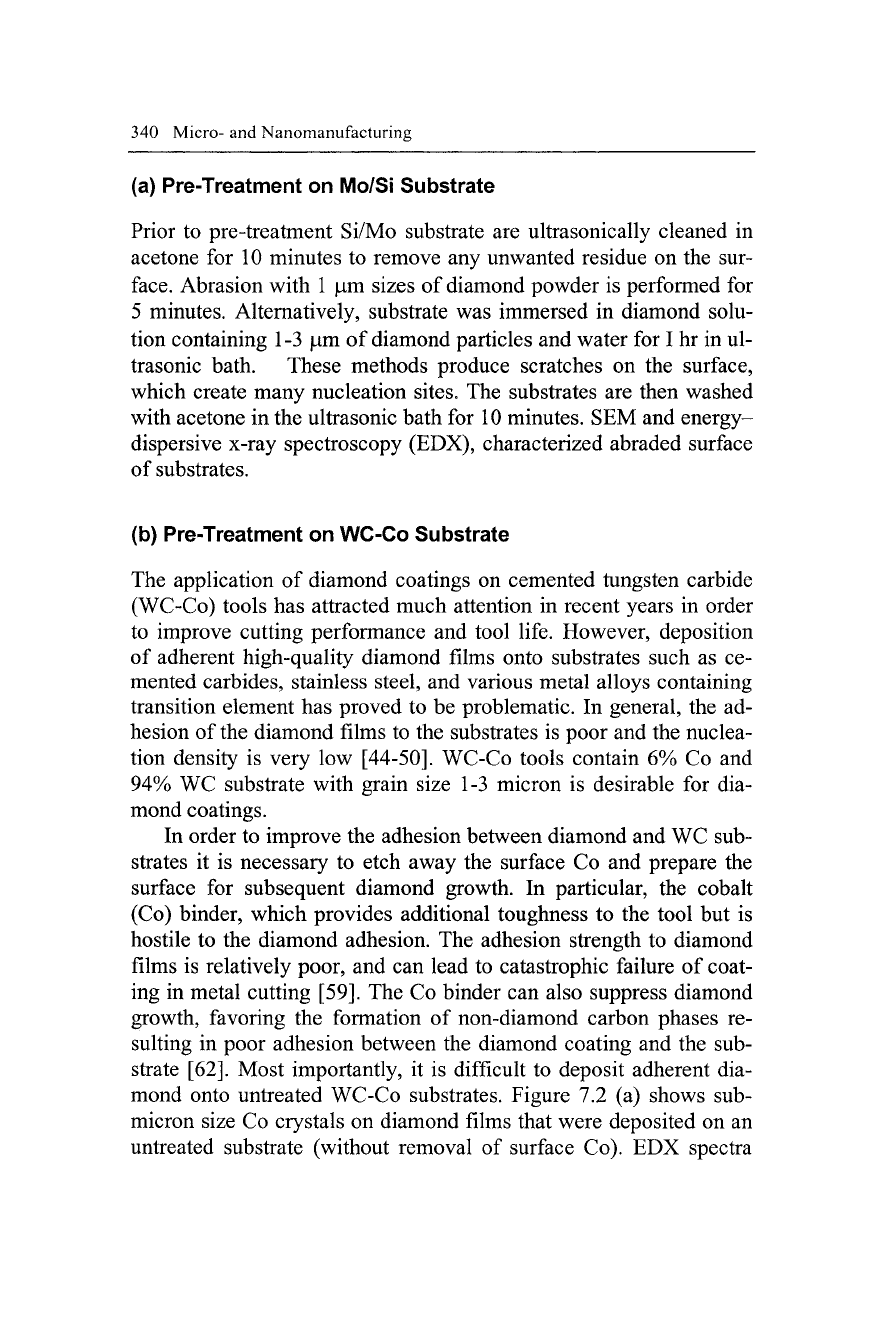
340 Micro- and Nanomanufacturing
(a) Pre-Treatment on Mo/Si Substrate
Prior to pre-treatment Si/Mo substrate are ultrasonically cleaned in
acetone for 10 minutes to remove any unwanted residue on the sur-
face.
Abrasion with 1 |Lim sizes of diamond powder is performed for
5 minutes. Alternatively, substrate was immersed in diamond solu-
tion containing
1 -3
|um of diamond particles and water for I hr in ul-
trasonic bath. These methods produce scratches on the surface,
which create many nucleation sites. The substrates are then washed
with acetone in the ultrasonic bath for 10 minutes. SEM and energy-
dispersive x-ray spectroscopy (EDX), characterized abraded surface
of substrates.
(b) Pre-Treatment on WC-Co Substrate
The application of diamond coatings on cemented tungsten carbide
(WC-Co) tools has attracted much attention in recent years in order
to improve cutting performance and tool life. However, deposition
of adherent high-quality diamond films onto substrates such as ce-
mented carbides, stainless steel, and various metal alloys containing
transition element has proved to be problematic. In general, the ad-
hesion of the diamond films to the substrates is poor and the nuclea-
tion density is very low [44-50]. WC-Co tools contain 6% Co and
94%
WC substrate with grain size 1-3 micron is desirable for dia-
mond coatings.
In order to improve the adhesion between diamond and WC sub-
strates it is necessary to etch away the surface Co and prepare the
surface for subsequent diamond growth. In particular, the cobalt
(Co) binder, which provides additional toughness to the tool but is
hostile to the diamond adhesion. The adhesion strength to diamond
films is relatively poor, and can lead to catastrophic failure of coat-
ing in metal cutting [59]. The Co binder can also suppress diamond
growth, favoring the formation of non-diamond carbon phases re-
sulting in poor adhesion between the diamond coating and the sub-
strate [62]. Most importantly, it is difficult to deposit adherent dia-
mond onto untreated WC-Co substrates. Figure 7.2 (a) shows sub-
micron size Co crystals on diamond films that were deposited on an
untreated substrate (without removal of surface Co). EDX spectra
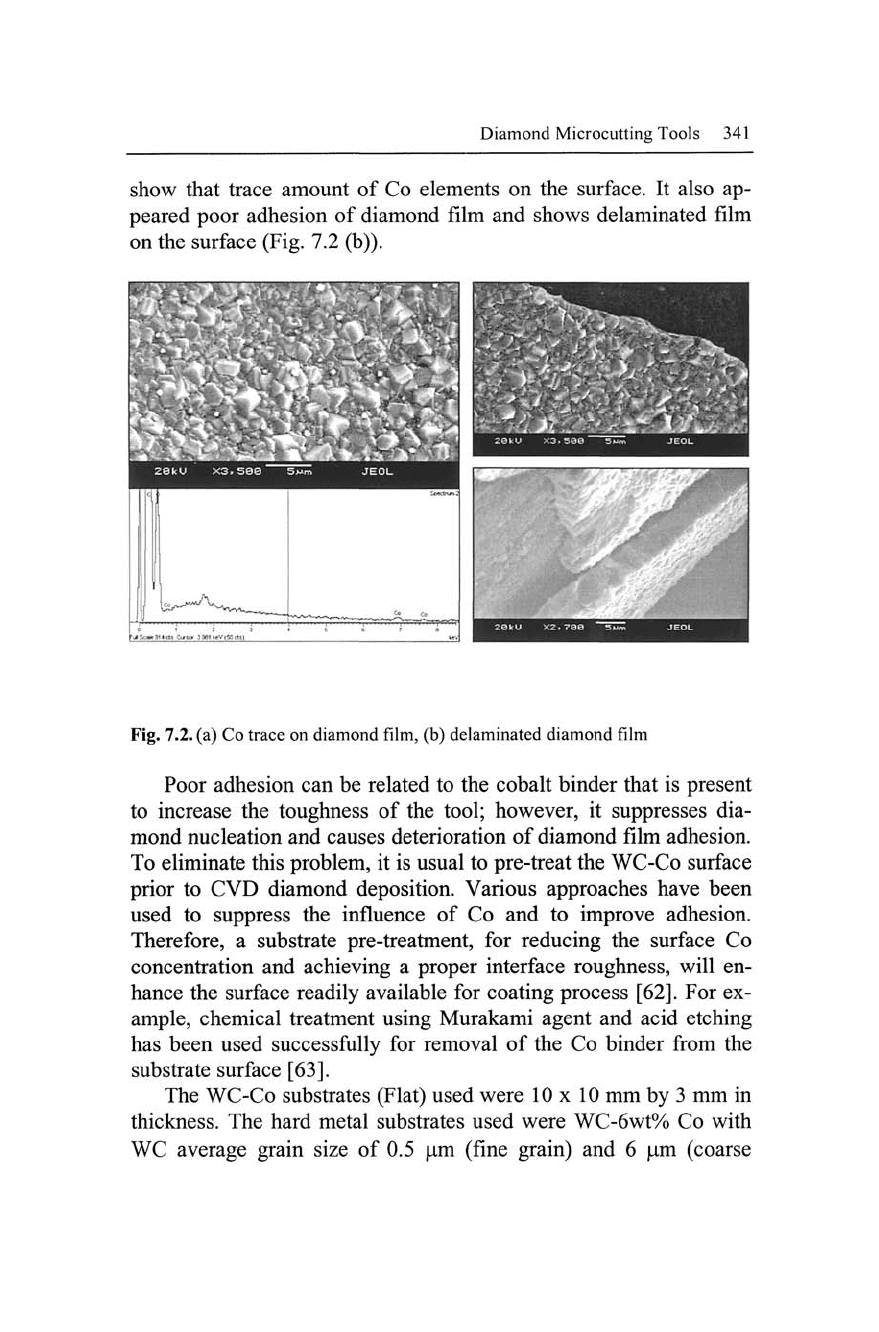
Diamond Microcutting Tools 341
show that trace amount of Co elements on the surface. It also ap-
peared poor adhesion of diamond film and shows delaminated film
on the surface (Fig. 7.2 (b)).
•••••••^
r<JScite914clj Oxio JSetteVffflc!:)
°
' '
^J
Fig. 7.2. (a) Co trace on diamond film, (b) delaminated diamond film
Poor adhesion can be related to the cobalt binder that is present
to increase the toughness of the tool; however, it suppresses dia-
mond nucleation and causes deterioration of diamond film adhesion.
To eliminate this problem, it is usual to pre-treat the WC-Co surface
prior to CVD diamond deposition. Various approaches have been
used to suppress the influence of Co and to improve adhesion.
Therefore, a substrate pre-treatment, for reducing the surface Co
concentration and achieving a proper interface roughness, will en-
hance the surface readily available for coating process [62]. For ex-
ample, chemical treatment using Murakami agent and acid etching
has been used successfully for removal of the Co binder from the
substrate surface [63].
The WC-Co substrates (Flat) used were 10x10 mm by 3 mm in
thickness. The hard metal substrates used were WC-6wt% Co with
WC average grain size of 0.5 |Lim (fine grain) and 6 |Lim (coarse
